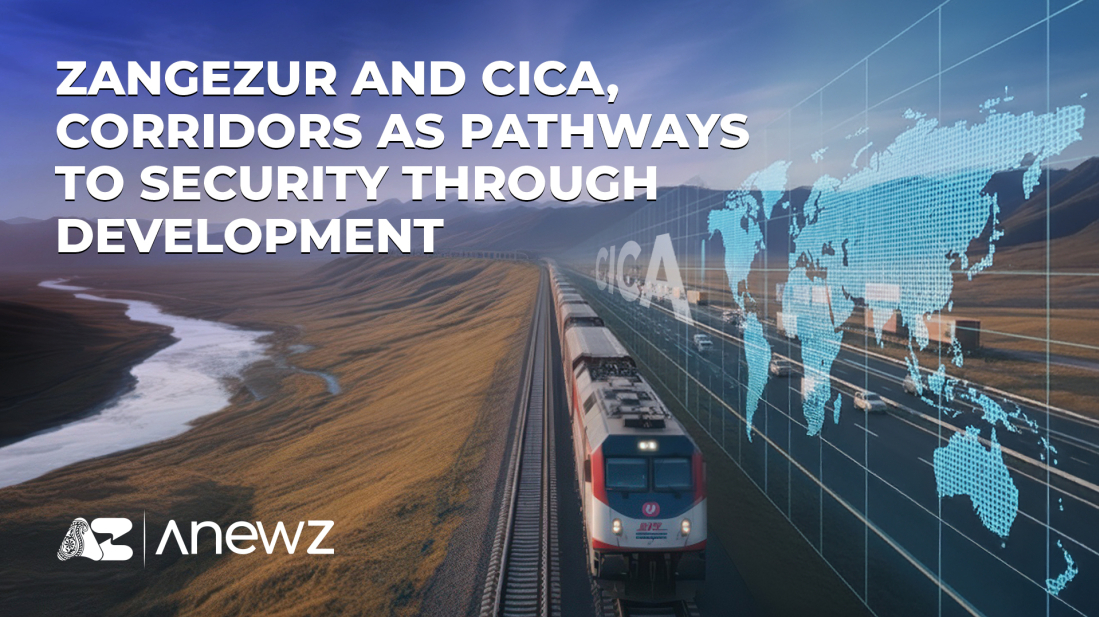Modi urges Indians to get rid of foreign products amidst strained U.S. ties
Indian Prime Minister Narendra Modi, in a public address on Sunday, urged citizens to stop purchasing foreign-made products and instead opt for local ...

The AnewZ Opinion section provides a platform for independent voices to share expert perspectives on global and regional issues. The views expressed are solely those of the authors and do not represent the official position of AnewZ
When President Ilham Aliyev described the Zangezur Corridor as a vital artery that will connect continents, his words pointed to more than new rail lines and roads. They spoke to a larger shift in how Azerbaijan is shaping its role in Eurasia, not only by investing in infrastructure but also by embedding that infrastructure within cooperative frameworks.
Corridors like Zangezur begin as minilateral projects among a handful of neighbors. Their long-term value, however, depends on being anchored in multilateral frameworks where the habits of cooperation can be scaled and sustained. That point resonates with the discussions at the CICA Think Tank Forum in Baku.
While much attention is given to formal statements, the more important takeaway is how Azerbaijan is demonstrating, through projects like Zangezur, what it means to turn CICA’s principles into practice. Corridors are where broad commitments take concrete form in harmonized customs, digital platforms, and cooperative problem-solving. They are where security through development becomes tangible.
Corridors as More Than Infrastructure
The Zangezur Corridor illustrates this principle more clearly than any other project underway in the region, showing how physical infrastructure, digital systems, and institutional arrangements come together in practice. The forty-three kilometer stretch connecting Azerbaijan’s mainland to Nakhchivan and through Türkiye to Europe is more than a line on the map. It is a test of how physical, digital, and institutional communication lines can reinforce one another.
The physical infrastructure is straightforward, railways and highways that shorten routes and provide redundancy. The digital layer is less visible but equally vital, customs platforms, e-queue systems, and shared data that smooth border crossings. The institutional dimension is the most consequential, harmonized tariffs, standardized inspections, and habits of consultation that keep trade flowing even when politics grow tense.
By advancing all three layers together, Azerbaijan is demonstrating how corridors can be more than transit projects. They can be instruments of what CICA calls security through development. Nearly three hundred block trains from China passed through Azerbaijan last year, with more expected this year. These numbers are important, but not as ends in themselves. They are evidence of growing predictability, which is what attracts investment, builds logistics hubs, creates jobs, and strengthens local communities.
Once livelihoods depend on continuity, stability becomes a shared interest. This is also where the interplay of minilaterals and multilaterals becomes so important. A corridor like Zangezur begins with immediate partners, Azerbaijan, Türkiye, Georgia, and Kazakhstan, but its long-term success requires the broader multilateral umbrella that CICA provides.
Shared Stakes Across Eurasia
The benefits of such corridors are not confined to Azerbaijan and its immediate partners. They extend outward across Eurasia, drawing in regional and global actors who each see their own interests reflected in the stability of the route. For Central Asian states, the Middle Corridor offers greater independence from northern transit routes and a chance to diversify their economic futures. For Türkiye, Zangezur consolidates its role as a bridge to Europe and the Turkic world. For China, diversification strengthens supply chain resilience and reduces the risk of overdependence on northern channels. For Europe, a shorter and more reliable East–West connection offers redundancy at a time when resilience is itself a strategic priority. For the United States, the corridor reflects an opportunity to engage with Eurasian partners on shared priorities such as transparent logistics, resilient supply chains, and diversified connectivity.
Each actor finds its own interest, but what they share is the incentive to keep the system predictable. That convergence of interest is what multilaterals are meant to preserve. Yet the same diversity of stakeholders also generates friction. Corridors stabilize trade, but they also redistribute leverage, shifting the balance of influence in ways that some welcome and others resist. For some, this redistribution represents new opportunity; for others, it signals a potential loss of long-standing roles.
This tension is particularly evident in the South Caucasus. Armenia approaches Zangezur through the lens of sovereignty, raising questions about how the corridor will be managed and by whom. Iran worries that the opening of a direct route between Azerbaijan and Türkiye will reduce its own function as a north–south transit bridge. Russia views the project through the prism of sanctions and its declining leverage over Eurasian trade, noting that each train that bypasses its territory further erodes its influence. These concerns are not simply about economics but about identity, sovereignty, and geopolitical relevance.
Here, CICA provides a useful framework. Its gradual transformation into a more structured multilateral platform creates space to address precisely these kinds of disputes. Security through development is not about eliminating tensions altogether but about ensuring they are mediated through shared stakes and predictable procedures. Embedding corridors like Zangezur in cooperative frameworks gives countries a channel to raise concerns without blocking progress.
Standardized forms, interoperable databases, and joint training programs are not just technical fixes; they function as confidence-building measures. Multiplied across borders, these practices reduce political temperature while building habits of trust. In this sense, the corridor and CICA reinforce each other, with the corridor making development tangible and CICA providing the institutional means to keep it on track. Together they turn potential flashpoints into opportunities for collective problem-solving.
From Fragility to Resilience
Fragility can mark the starting point of connectivity, but resilience is what ensures its survival. The story of Zangezur finds parallels across the Global South, where shared infrastructure has gradually been transformed into shared security. Corridors rarely begin as polished systems. They emerge from uneven negotiations, competing interests, and fragile compromises. Yet when embedded in wider cooperative frameworks, they can evolve into resilient platforms that strengthen both economies and governance.
Southern Africa offers one example. The Maputo Development Corridor began as a bilateral experiment but gained durability once it was reinforced by the Southern African Development Community. Southeast Asia offers another. ASEAN’s North–South Economic Corridor linked a cluster of neighboring states, but it only achieved stability when embedded in regional agreements that normalized cooperation. In both cases, early fragility was not the end of the story but the beginning of a longer process of institutional reinforcement.
The same dynamic is now unfolding in the South Caucasus. CICA’s charter discussions and Azerbaijan’s progress on Zangezur are converging at a critical moment. The test will be whether new multilateral rules can meet the practical needs of corridors: faster border crossings, interoperable digital systems, and joint crisis protocols. These are not simply technical details but questions of governance. Each time a container moves on schedule because a customs form is harmonized, or a dispute is resolved through consultation rather than confrontation, CICA’s transformation moves from principle to practice.
Azerbaijan’s wager is simple. Build habits of trust first, and the traffic will follow. Zangezur is already proving that when neighbors cooperate on practical issues, development gains momentum and stability follows. As Azerbaijan chairs CICA during this pivotal period, the country has the opportunity to translate corridor politics into institutional progress. By linking the Zangezur project with CICA’s broader framework, Baku is positioning Eurasia to move from fragility to resilience. Corridors, in this vision, are not only arteries of commerce, they are the architecture of trust.
Dr. Rachael M. Rudolph is an Assistant Professor of Social Science at Bryant-University-Beijing Institute of Technology, Zhuhai College, Adjunct Professor of Counterterrorism and Cultural Intelligence at Nichols College, and consultant at RMR Consulting Services, LLC.
AnewZ has learned that India has once again blocked Azerbaijan’s application for full membership in the Shanghai Cooperation Organisation, while Pakistan’s recent decision to consider diplomatic relations with Armenia has been coordinated with Baku as part of Azerbaijan’s peace agenda.
A day of mourning has been declared in Portugal to pay respect to victims who lost their lives in the Lisbon Funicular crash which happened on Wednesday evening.
A Polish Air Force pilot was killed on Thursday when an F-16 fighter jet crashed during a training flight ahead of the 2025 Radom International Air Show.
Video from the USGS (United States Geological Survey) showed on Friday (19 September) the Kilauea volcano in Hawaii erupting and spewing lava.
Global finance is entering a new era. The long-standing dominance of the US dollar is showing signs of strain as political conflicts and financial sanctions push countries to seek alternatives.
Under a photo showing Russian President Vladimir Putin, Chinese President Xi Jinping, and Indian Prime Minister Narendra Modi—likely taken at the recent Shanghai Cooperation Organization (SCO) summit in Tianjin—Donald Trump took to Truth Social on September 5 with a sarcastic but regretful post.
Thirty years after launching its ambitious Euro-Mediterranean policy, Europe has lost influence in a region that should matter most to it. Today, in the Mediterranean, the European Union no longer sets the rules of the game, it endures them.
On 2 September, spot gold briefly broke through the historic threshold of $3,500 an ounce, before settling just under that level at $3,494. This rally not only eclipsed the previous peak set in April but also cemented gold’s position as one of the best-performing assets of 2025.
You can download the AnewZ application from Play Store and the App Store.

What is your opinion on this topic?
Leave the first comment